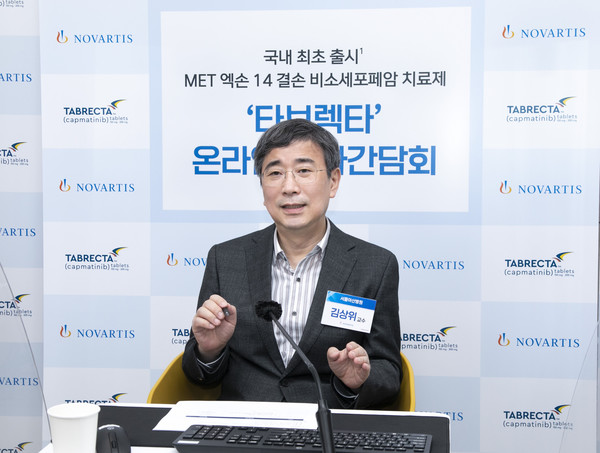Novartis Korea aims to address the unmet needs of non-small cell lung cancer (NSCLC) patients with MET exon 14 skipping mutation with the launch of Tabrecta, the company said Tuesday.

"Lung cancer is the third most common cancer in Korea, and NSCLC has a five-year relative survival rate of only 8.9 percent when metastasized," said Professor Kim Sang-we at Asan Medical Center during the press conference. "MET exon 14 skipping mutation NSCLC, which corresponds to a representative MET mutation, accounts for about 3-4 percent of NSCLC patients."
According to Kim, when MET exon 14 skipping occurs, it overstimulates the MET pathway, which plays an important role in cell signaling, proliferation, and survival, and causes cancer cell proliferation. Kim stressed that cancer has a high unmet medical need due to a poor prognosis.
He expected Tabrecta to address unmet medical needs, as the drug confirmed efficacy in the GEOMETRY-mono1 study, the basis for its approval.
"The drug showed a high objective response rate (ORR) of 68 percent in patients receiving it as primary treatment, and an ORR of 41 percent of patients receiving it as a secondary treatment or more," Kim said. "The treatment even demonstrated efficacy for patients with brain metastasis with an intracranial ORR of 92 percent."
Also, in a retrospective analysis of Koreans, he said the median overall survival time was 21.5 months, proving its effectiveness.
Kim added that based on such clinical results, Tabrecta is the only MET inhibitor that the National Comprehensive Cancer Network (NCCN) guidelines recommend for treating non-small cell lung cancer with confirmed brain metastasis.
During the meeting, Kim also stressed the importance of genetic testing to diagnose lung cancer accurately as cancer with high gene mutation.
"There are many treatments for NSCLC, but there are still various mutations that cause cancer to grow," Kim said. "Some studies have even found that about 92.4 percent of NSCLC patients have a genetic mutation."
Kim explained that when deciding on chemotherapy for NSCLC with many genetic mutations, it is necessary to check the molecular pathological information of the patient's cancer and select the treatment accordingly.
"It is very important to check whether there is a corresponding gene mutation because the targeted therapeutic agent will have a good effect," Kim said. "Genetic mutations can be confirmed using next-generation sequencing (NGS) techniques, but there are barriers as it takes a considerable amount of time to obtain results."
However, Kim added that the waiting period is getting shorter to less than 2-3 weeks abroad.
Kim stressed that he believes that the time will further decrease in the future.
Novartis Korea said that the company is also considering applying a cheaper and simpler real-time polymerase chain reaction (RT-PCR) method in detecting the mutations.
"Much attention is paid to economical alternatives like RT-PCR, and Novartis is also working with a multinational diagnostic device company to introduce the technology into the field," Novartis Korea’s oncology brand manager, Kim Seung-eun, said. "If RT-PCR equipment becomes possible, I think that outsourcing diagnosis will be possible even in hospitals where it is difficult to conduct NGS tests."

